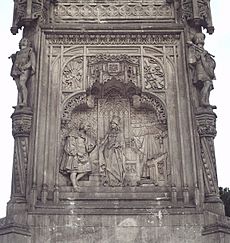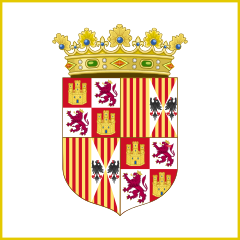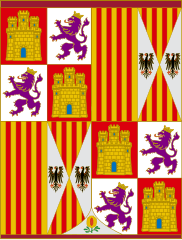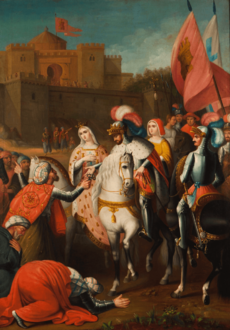Catholic Monarchs of Spain facts for kids
The Catholic Monarchs were Queen Isabella I of Castile and King Ferdinand II of Aragon. Their marriage and shared rule brought the kingdoms of Castile and Aragon together. This was a big step towards forming modern Spain. They were both from the House of Trastámara family. They were also second cousins, meaning they shared a great-grandparent. To marry, they needed special permission from the Pope, called a papal dispensation. Pope Sixtus IV gave them this permission. They married on October 19, 1469, in Valladolid. Isabella was 18, and Ferdinand was 17. Many historians agree that their marriage was key to Spain's unification. Their time as rulers is often called "the most glorious epoch in the history of Spain."
Spain became a union of two crowns, not a single country right away. Castile and Aragon kept their own laws until the 1700s. Isabella and Ferdinand often traveled to different towns. This helped them get support from local leaders. In 1494, Pope Alexander VI officially gave them the title "Catholic King and Queen." This was to recognize their strong defense of the Catholic faith.
Contents
How Isabella and Ferdinand Married
When they married on October 19, 1469, Isabella was 18. She was the likely future queen of Castile. Ferdinand was 17. He was the likely future king of Aragon. They met for the first time in Valladolid in 1469. They married within a week. From the start, they had a strong bond and worked well together. They knew that gaining the crown of Castile was very important. Their marriage was a big step toward uniting the lands on the Iberian peninsula. These lands would later become Spain.
Since they were second cousins, they needed special permission from the Pope to marry. Pope Paul II did not want to give them this permission. So, they created a fake papal document. It is not clear who made the fake document. Some experts think it was Carrillo de Acuña, the Archbishop of Toledo. Others believe it was Antonio Veneris.
Isabella's claim to the throne was not fully secure. Her marriage to Ferdinand angered her half-brother, Henry IV of Castile. He had previously agreed she would be his heir. But he changed his mind after their marriage. When Henry died in 1474, Isabella claimed the throne. However, her niece, Joanna, also claimed it. Joanna was 13 and sought help from her husband, Afonso V of Portugal. This led to the War of the Castilian Succession (1475–79). Isabella asked Aragon for help. Her husband Ferdinand and his father, Juan II of Aragon, provided support. Isabella's supporters made sure she was recognized as the only heir to Castile. Juan II died in 1479. Ferdinand became King of Aragon in January 1479.
In September 1479, Portugal and the Catholic Monarchs signed the Treaty of Alcáçovas. This treaty settled important issues, including Isabella's right to the Castilian crown. By working closely, the royal couple gained strong political power. Ferdinand's father had told them that "neither was powerful without the other." Their marriage united the two kingdoms. This led to the start of modern Spain. Yet, they ruled their kingdoms mostly on their own. Their kingdoms kept their own laws and governments for centuries.
Royal Symbols and Sayings
The coat of arms of the Catholic Monarchs was designed by Antonio de Nebrija. It showed how they worked together. Their shared motto was Tanto monta. This means "as much one as the other." It showed their equal partnership. The motto first referred to the Gordian knot. It meant "It's the same, cutting or untying." Later, it meant "Isabella is the same as Ferdinand."
Their emblems were a yoke and a bundle of arrows. The 'Y' and 'F' stood for Ysabel (Isabella's old spelling) and Fernando. A double yoke is used by two oxen, showing their teamwork. Isabella's arrows showed the crown's power. It warned people to respect royal authority and justice. These symbols were used everywhere. Later, a Spanish political party, the Falange, used these badges. They claimed to follow the ideals of the Catholic Monarchs.
Royal Councils and Government
The Catholic Monarchs created a system of Royal Councils. These councils helped them govern different regions or areas. Isabella became Queen of Castile in 1474. Ferdinand was still the future king of Aragon. With Aragon's help, Isabella secured her claim to the throne. Ferdinand spent more time in Castile at first. This was because his father still ruled Aragon. Even after he became King of Aragon in 1479, he stayed mostly in Castile. This caused some problems for Aragon.
To fix this, they created the Council of Aragon in 1494. This joined the Council of Castile, which was set up in 1480. The Council of Castile was the main governing body for Castile. It had wide powers. The monarchs appointed loyal officials to it. They kept the old noble families from having too much power there. The monarchs also created the Spanish Inquisition in 1478. Its goal was to make sure people who converted to Christianity did not secretly go back to their old faiths. They also created the Council of the Crusade. This council managed money from selling special religious documents. In 1498, Ferdinand gained control of the rich Spanish military orders. He then created the Council of Military Orders to oversee them. This system of councils continued after their rule. Their grandson, Charles V, Holy Roman Emperor, created even more councils.
Changes at Home
The Catholic Monarchs wanted to bring back royal power in Spain. First, they created a group called the Holy Brotherhood. These men acted as a police force in Castile. They also helped keep the Castilian nobles in line. To create a fairer justice system, the monarchs set up the Royal Council. They appointed judges to run the towns and cities. This strengthening of royal power is known as the Pacification of Castile. It was a key step toward making Spain one of Europe's first strong nations.
Isabella also tried to lessen the power of the Cortes Generales (parliament) in Castile. Ferdinand, being from Aragon, did not do this in his own kingdom. Even after his death, the Aragonese, Catalan, and Valencian parliaments kept much power. The monarchs also traveled a lot. They moved from town to town to encourage loyalty to the crown. This was different from having one main government center. Each community was connected to them through loyalty, not just through rules.
Religious Policies
The Catholic Monarchs wanted to unite all the kingdoms of the Iberian Peninsula. Their rule also focused on religious unity through strong Catholicism. They asked the Pope for permission. In 1478, Pope Sixtus IV allowed them to create the Holy Office of the Inquisition in Castile. This was to ensure that Jewish and Muslim people who became Christians did not secretly return to their old faiths. The Pope gave the monarchs full power to name inquisitors. But the Pope still formally appointed them. The Inquisition did not have power over Jews and Muslims who did not convert. Since Aragon already had an Inquisition since 1248, the Spanish Inquisition became the only shared institution for both kingdoms. Pope Innocent VIII confirmed Tomás de Torquemada as the Grand Inquisitor of Spain. Torquemada was Isabella's confessor. He was very strict with converted Jews (conversos) and Muslims (moriscos). The Pope also gave the monarchs the right to choose church leaders in Granada and the Canary Islands. This gave the state control over religious matters.
The monarchs started a series of wars called the Granada War (1482–92). Pope Sixtus IV helped by giving them church money and a special tax for the war. After 10 years, the Granada War ended in 1492. Emir Boabdil surrendered the Alhambra Palace in Granada to the Castilian soldiers. With Granada's fall in January 1492, Isabella and Ferdinand continued their religious unity policies. They especially focused on expelling Jews who refused to become Christians.
After some uprisings, Ferdinand and Isabella ordered all Jews to leave Spain. This was known as the Alhambra Decree. People who converted to Catholicism were allowed to stay. However, between 1480 and 1492, many converts were accused of secretly practicing their old religion. These people were arrested, jailed, and questioned. The Inquisition was created in the 12th century to fight against beliefs that went against Catholic teachings. The Catholic Monarchs decided to bring the Inquisition to Castile. On November 1, 1478, Pope Sixtus IV issued a document. This document established the Inquisition in Castile. It was later extended to all of Spain. The document gave the monarchs the sole power to name the inquisitors.
During the rule of the Catholic Monarchs and long after, the Inquisition was active. It prosecuted people for not following Catholic beliefs. This included secret Jewish practices, other heresies, and bigamy. The last trial for secret Jewish practices was in 1818. In 1492, the monarchs issued the Alhambra Decree. This gave Jews in Spain four months to either convert to Catholicism or leave Spain. Tens of thousands of Jews moved to other places. These included Portugal, North Africa, Italy, and the Ottoman Empire.
Foreign Relations

The Catholic Monarchs worked together on many things. But their foreign policy was sometimes different. This was because of the separate histories of their kingdoms. Despite this, they had a very successful foreign policy. Their victory over the Muslims in Granada allowed Ferdinand to get involved in matters outside Spain.
King Ferdinand continued Aragon's traditional foreign policy. Aragon was interested in the Mediterranean Sea and wanted to conquer lands in North Africa. Aragon had a long rivalry with France. France had been a traditional ally of Castile. Castile's foreign interests were focused on the Atlantic Ocean. So, Castile's funding of Columbus's voyage was a natural extension of its existing interests.
Castile had good relations with the neighboring Kingdom of Portugal. After Portugal lost the War of the Castilian Succession, Castile and Portugal signed the Treaty of Alcáçovas. This treaty set boundaries for overseas exploration. At the time, it seemed less favorable to Castile. But it settled any future Portuguese claims to the Castilian crown. Portugal did not take advantage of Castile and Aragon focusing on the reconquest of Granada. After good relations were restored, the Catholic Monarchs arranged two important marriages with Portuguese royalty.
The monarchs arranged good marriages for their five children. This was to create royal alliances for Spain's long-term benefit. Their first child, Isabella, married Afonso of Portugal. This created strong ties between the two kingdoms. It led to lasting peace and future alliances. Their second daughter, Joanna, married Philip the Handsome. He was the son of Maximilian I, Holy Roman Emperor. This ensured an alliance with the powerful Holy Roman Empire. This helped Spain's future political safety. Their only son, John, married Margaret of Austria. This kept ties with the Habsburg family, on whom Spain relied. Their fourth child, Maria, married Manuel I of Portugal. This strengthened the link made by Isabella's older sister's marriage. Their fifth child, Catherine, married Arthur, Prince of Wales in 1501. He was the heir to the English throne. He died a few months later at age 15. She then married his younger brother, who became King Henry VIII of England in 1509. Not all these alliances lasted. Their only son, John, died young. Catherine was divorced by Henry VIII. Joanna's husband Philip also died young. Joanna was considered unable to rule.
Under the Catholic Monarchs, a strong army loyal to the Crown was created. It was led by the Castilian Gonzalo Fernández de Córdoba. He was known as the Great Captain. Fernández de Córdoba reorganized the army into new units called tercios reales. This created the first modern army that answered directly to the crown, not to nobles.
Christopher Columbus's Voyages
Through the Capitulations of Santa Fe, the explorer Christopher Columbus received money. He was allowed to sail west and claim lands for Spain. The monarchs gave him the title Admiral of the Ocean Sea. He also received many special rights. His journey west led to Europeans settling the Americas. It also brought knowledge of these lands to Europe.
Columbus's first trip landed in the Bahamas on October 12, 1492. He thought he had reached the Indies. Queen Isabella had provided the money for the trip. So, the benefits went to the Kingdom of Castile. Columbus landed on an island he called San Salvador. He then went to Cuba, naming it Juana. He finished his journey on the island of the Dominican Republic and Haiti. He called it Hispaniola, or La Isla Española (the Spanish Island).
On his second trip, in 1493, he found more Caribbean islands, including Puerto Rico. His main goal was to settle the lands he had found. He brought 1500 men with him this time. Columbus finished his last expedition in 1498. He discovered Trinidad and the coast of present-day Venezuela. The colonies Columbus started, and later conquests in the Americas, brought a lot of wealth to Spain. This made Spain the main power in Europe from the late 1400s to the mid-1600s. It was also the largest empire until 1810.
Their Deaths
Isabella died in 1504. This ended the very successful political and personal partnership of their marriage. Ferdinand remarried Germaine of Foix in 1505. But they did not have any children who lived. If they had, Aragon would likely have separated from Castile. The Catholic Monarchs' daughter Joanna became Queen of Castile. But she was considered unable to rule. After her husband Philip the Fair died, Ferdinand remained in power in Castile as regent until his death. Joanna was kept confined. Ferdinand died in 1516. He is buried next to Isabella in Granada. This was the city where they had their great victory in 1492. Joanna's son Charles I of Spain (also Charles V, Holy Roman Emperor) came to Spain. Joanna, still confined in Tordesillas, was the official co-ruler of both Castile and Aragon until her death. When she died, Charles inherited all the lands his grandparents had gathered. He also brought the Habsburg lands in Europe into the growing Spanish Empire.
See also
 In Spanish: Reyes Católicos para niños
In Spanish: Reyes Católicos para niños












